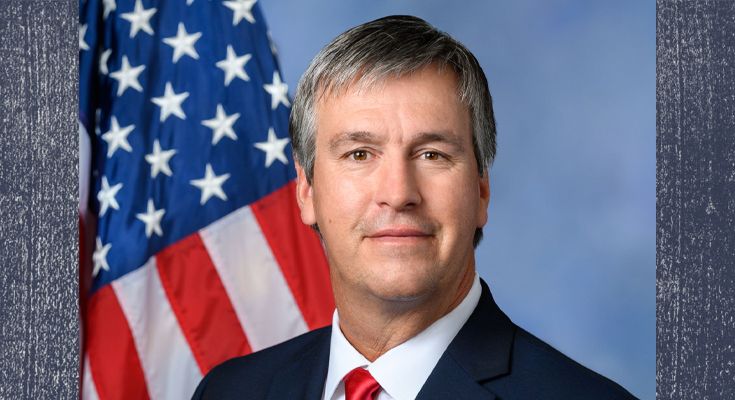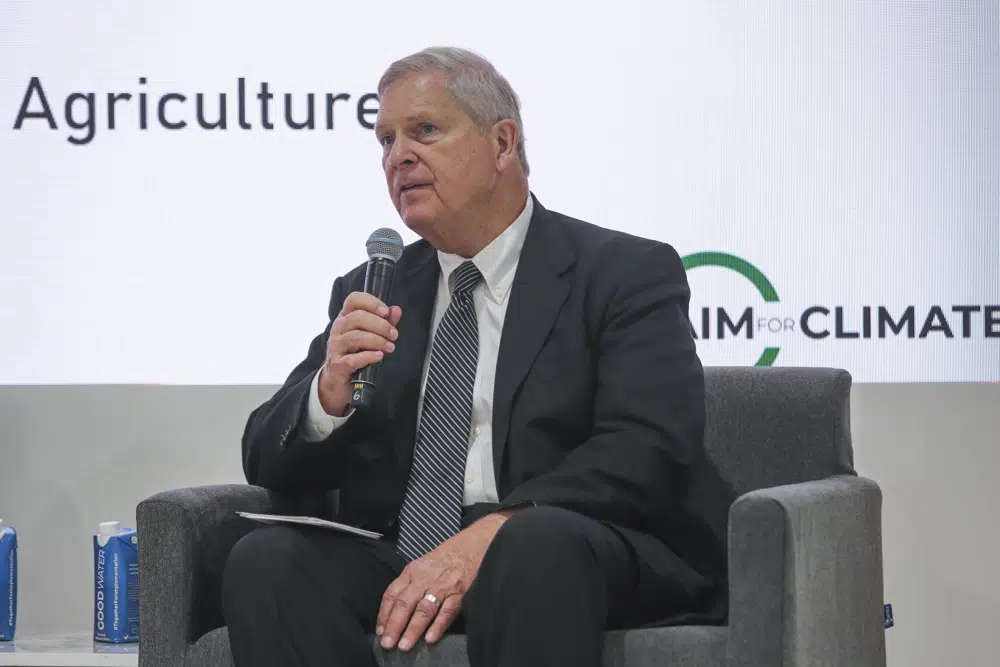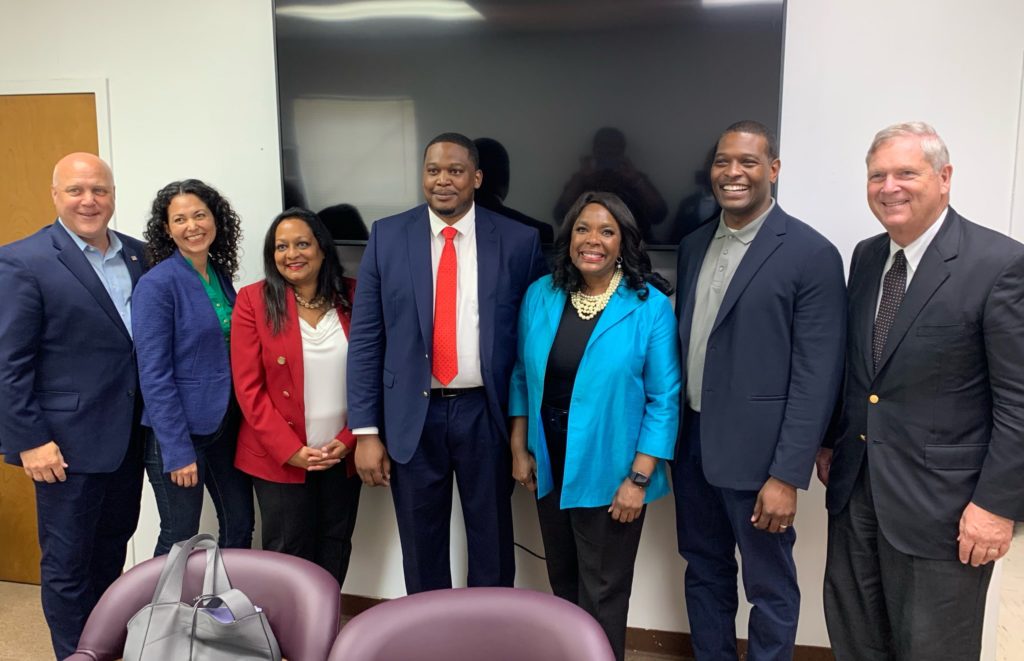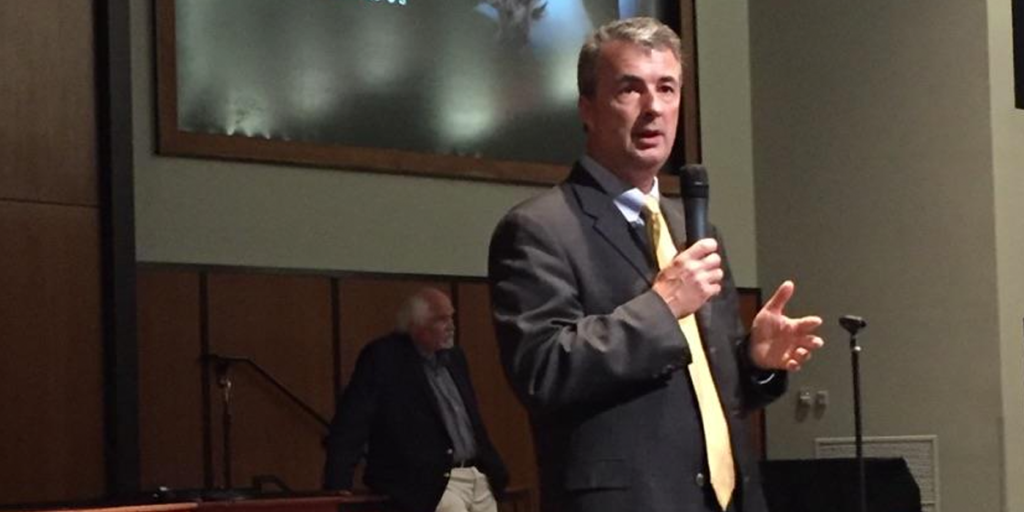Ag officials: Drastic drop in U.S. farms over 4 decades causing pain in rural areas

By Andrew Hensel | The Center Square According to the United States Department of Agriculture, a lack of farms throughout the country impacts families in more ways than one. U.S. Agriculture Secretary Tom Vilsack, U.S. Rep. Robin Kelly, D-Illinois, and others discussed the state of farming in Illinois and elsewhere Monday in Kankakee. Vilsack told an agricultural panel that the country is losing farms in large quantities. “I was surprised to learn that we’ve lost 438,000 farms since 1981,” Vilsack said. “Just to give you a sense of how many farms that is, it is every farm in Iowa today, Minnesota, Wisconsin, Illinois, South Dakota, Nebraska, and Colorado.” Over that same period, 141.1 million acres of former farmland are no longer being farmed today across the country. Illinois is the top soybean producer in the country, with 15% of all U.S. soybeans being produced in Illinois. Vilsack said the lack of farms is impacting different areas. “That’s a lot of land,” Vilsack said. “Are we OK with that?” “It has an impact on communities because when you lose that many farms, you don’t just lose those farms, you also lose the small businesses that depend on those farms,” Vilsack said. “Which is why many small towns in this country today in rural places have empty storefronts.” According to Vilsack, the way to address the problems in farming is by creating more revenue streams for farmers, especially small and mid-sized farmers. “The key here is for these farming operations in particular to have additional revenue streams that come in at the same time they’re selling a crop, or selling livestock, or getting a government payment,” Vilsack said. Numbers from the Illinois Farm Bureau show that Illinois is the second top corn-producing state in the country, with 13% of our country’s supply of corn being grown on Illinois farms. That farmland makes up 76% of Illinois land. Republished with the permission of The Center Square.
Federal government shutdown to impact farmers, others

By Greg Bishop | The Center Square With the potential for a partial federal government shutdown looming this weekend, officials across the states are bracing for possible impact. A series of spending measures to keep various sectors of the federal government funded is tied up in Washington, D.C., with a Democrat-controlled Senate at odds with a Republican-controlled House. While Supplemental Nutrition Assistance Program subsidies are set for October, U.S. Department of Agriculture Secretary Tom Vilsack warned what a shutdown could mean to nearly 168,000 beneficiaries of the federally-funded Women, Infants and Children nutrition program in Illinois. “We have a contingency fund at USDA that might continue that for a day or two. Some states have leftover WIC benefits that have not been spent, which could extend it for a week or so in that state, but the vast majority of WIC participants would see an immediate reduction and elimination of those benefits, which means the nutrition assistance provided would not be available,” Vilsack said. The Illinois Department of Human Services said it is monitoring the situation, but the agency believes both SNAP and WIC benefits would not be impacted for Illinois customers during the month of October. Farmers are bracing for a possible shutdown and for continued uncertainty on an updated farm bill. Illinois Farm Bureau’s Kevin Semlow said a shutdown would have an impact on farm finances by halting various federally subsidized farm loans. The timing comes during harvest when people are looking to get the best commodity prices. “Especially the marketing assistance loans, which help the farmers plan for and start buying their inputs for next year,” Semlow told The Center Square. “For many farmers, that’s a key tool in their financial tool belt that they need to have, and without those offices being open, they will not be able to go in and start that process.” Jumping from one crisis to the next, another deadline farmers are eyeing is the end of the month sunset of the five-year farm bill. “It’s gonna push that back, but we’re still hopeful and optimistic that Congress can bring closure to the budget impasse quickly, which allows them to move onto other pressing issues such as the farm bill,” Semlow said. If the federal government shuts down on Sunday, Vilsack said that could limit technical assistance for legislators wanting to continue crafting a new farm bill. Republished with the permission of The Center Square.
Biden administration spending $150M to help small forest owners benefit from selling carbon credits

The Biden administration said Tuesday it will spend $150 million to help owners of small parcels of forestland partner with companies willing to pay them for carbon offsets and other environmental credits. Agriculture Secretary Tom Vilsack announced the grant program at a conference of Black landowners in coastal Georgia, saying programs that allow private companies to offset their own emissions by paying to protect trees have disproportionately benefited owners of large acreage. “In order for those small, privately held forest owners to be able to do what they need and want to do requires a bit of technical help,” Vilsack told about 150 conference attendees in a church ballroom in Brunswick. “And sometimes that technical help is not easy to find. And it’s certainly not easy to afford.” The grant money comes from the sweeping climate law passed by Congress just over a year ago, and targets underserved landowners, including military veterans and new farmers, as well as families owning 2,500 acres (1,011 hectares) or less. The goal is to protect more tracts of U.S. forest to help fight climate change. The past decade has seen a rapidly expanding market in which companies pay landowners to grow or conserve trees, which absorb carbon from the atmosphere, to counterbalance their own carbon emissions. For owners of smaller family tracts, selling carbon offsets or other credits would give them an alternative income to harvesting their timber or selling their property to a developer. Companies are pouring billions of dollars into environmental credits, but small landowners face daunting barriers to eligibility, said Rita Hite, president and CEO of the American Forest Foundation. To participate, owners need to take an inventory of their forested property, have a land management plan, and run models to calculate the land’s carbon value. “Previously, if you didn’t have 5,000 acres or more, you weren’t participating in these markets,” Hite said. “Not only are there technical hurdles, but also financing hurdles.” The American Forest Foundation and the Nature Conservancy launched a joint program four years ago that covers many of the costs for family land owners to sell carbon offsets for their land. Those groups and other nonprofits will be eligible to apply for grants of up to $25 million to provide direct help to landowners under the Biden administration’s program. So will state forestry agencies, university agricultural extension services and others The money could pay professionals to help owners develop land management plans or to connect them with project managers who serve as middlemen between owners and companies seeking environmental credits. The grants were welcomed by John Littles, a leader of the Sustainable Forestry and African American Land Retention Network hosting the Georgia conference. The group represents 1,600 Black landowners across eight Southern states — Alabama, Arkansas, Georgia, Mississippi, North Carolina, South Carolina, Texas, and Virginia. “Most of the time, we’re left out — more specifically, people of color,” Littles said. “We’re not afforded the opportunity to help design the programs, so the programs are mainly now designed for large landholdings and large acreage.” Littles said his network plans to apply for a grant under the new program. But he’s not sure how much demand there will be from landowners. He said that will largely depend on whether owners of smaller acreages can get enough money from conservation credits. “I think it’s still early to tell,” Littles said. “But it has to be a benefit for the landowners.” Hite of the American Forest Foundation said landowners with small acreage shouldn’t expect big profits from selling environmental credits. She said owners enrolled in the group’s Family Forest Carbon Program earn on average about $10 per acre in a year. “Is this going to matter for a 30-acre landowner? It’s not going to make them rich,” Hite said. “But it will probably pay the taxes.” Republished with the permission of The Associated Press.
Rep. Barry Moore urges USDA to help restore Chinese poultry market access

Last week, Rep. Barry Moore, Rep. Abigail Spanberger (R-Virginia), and 41 Members of Congress, including House Agriculture Committee Chairman Glen Thompson, led a letter to Agriculture Secretary Tom Vilsack and U.S. Trade Ambassador Katherine Tai urging the General Administration of Customs China (GACC) to engage with the United States Department of Agriculture (USDA) Animal Plant and Health Inspection Service (APHIS) and to honor their 2020 trade agreement by restoring market access to states who followed agreed upon Highly Pathogenic Avian Influenza protocols. These affected states include 158 poultry processing and cold storage facilities and represent 43 percent of boiler production in the United States. “Poultry producers are under pressure not only to protect animal health but market health, too. American producers bet on reliable trading partners, and China is not holding up their end of the deal,” said Rep. Moore. “I urge Secretary Vilsack and Ambassador Tai to engage with their Chinese counterparts and encourage them to honor the 2020 agreement and restore American market access.” Congressman Glenn Thompson is the Chairman of the House Committee on Agriculture. “Trade is one of our most valuable tools to stimulate the economy, and China’s disregard for existing regionalization protocols is negatively impacting our poultry industry,” said Rep. Thompson. “Our nation’s growers follow long-standing guidelines to ensure the health and safety of poultry products. The Biden Administration must engage with the GACC to uphold our trade agreements and reopen this critical export market for U.S. poultry.” Commercial Poultry in Alabama generates more than $15 billion in revenue annually. It accounts for 65.6% of annual farming revenue in the state and employs more than 86,000 Alabama workers on farms, processing plants, and allied industries. The U.S. shipped about $732 million worth of broilers to Chinese buyers in 2020. That’s about 21% of total U.S. exports worldwide. Many of those chickens were raised in Alabama. In 2021, China imported $3.1B in Poultry Meat, becoming the world’s largest importer. China imports Poultry Meat primarily from Brazil ($1.27B), the United States ($908M), Thailand ($327M), Russia ($250M), and Argentina ($137M). Cutting off that market, especially with high input prices for feedstuffs and energy, could negatively impact Alabama poultry farmers. Barry Moore is in his second term representing Alabama’s Second Congressional District. To connect with the author of this story or to comment, email brandonmreporter@gmail.com.
Tommy Tuberville pushes to permanently repeal death tax

U.S. Senator Tommy Tuberville joined Sen. John Thune in reintroducing legislation to abolish the federal Estate Tax and cut red tape that is imposing increased restrictions on working families. The two senators previously introduced this legislation in 2021. “The Death Tax destroys American jobs by stifling profitable businesses that employ hardworking Americans,” said Sen. Tuberville. “Our government should be focused on creating an economic environment that preserves small businesses and family farms instead of taxing them out of operation. I will keep pushing for policies that incentivize our next generation of farmers and business owners so that we can continue to rely on their contributions for a strong economy.” “Agriculture is the backbone of South Dakota’s economy,” said Thune. “For years, I have fought to protect farm and ranch families from the onerous and unfair death tax. Family-owned farms and ranches often bear the brunt of this tax, which makes it difficult and costly to pass these businesses down to future generations. I will continue to do everything in my power to remove these roadblocks for family businesses and repeal the death tax once and for all.” “For far too long, the death tax has wreaked havoc on farm families and small businesses across Kentucky,” said Senate Minority Leader Mitch McConnell. “The burden of this unfair and punitive tax can be devastating for families who only want to pass down their hard-earned livelihoods to the next generation. Washington Democrats need to recognize the economic damage they’ve inflicted and join Republicans in ending this harmful tax. I0000’m proud to stand with Senator Thune for repealing the death tax for good. Kentuckians must be allowed to build upon the legacies of their family farms without fear of financial ruin.” Alabama Farmers Federation President Jimmy Parnell also supports the legislation. “Farming is a capital-intensive business with many of the assets such as land and equipment tied to the operation of the farm,” Parnell explained. “Without cash on hand, a family could be forced to sell these assets just to pay the tax burden, jeopardizing the viability of the farm. We need tax policies that encourage profitability of current farmers and the next generation of farmers, and repealing the estate tax is a huge step in the right direction.” Todd Wilkinson is the President of the National Cattlemen’s Beef Association. “No cattle producer should ever be forced to sell their family’s farm or ranch to pay a tax bill due to the death of a family member,” said Wilkinson. “Repealing the death tax is a commonsense way to keep the farm or ranch in the family. As a land-based, capital-intensive industry, most cattle-producing families are asset-rich and cash-poor, with few options to pay off tax liabilities. It is unacceptable that some families are forced to sell off land, farm equipment, parts of the operation, or the entire ranch to pay the estate tax. We need a tax code that promotes the continuation of family-owned businesses instead of breaking them up.” American Farm Bureau explained on their website, “Almost all farmers and ranchers have benefited greatly from congressional action that increased the estate tax exemption to $11 million per person/ $22 million per couple (indexed for inflation), provided portability between spouses, and continued the stepped-up basis. Instead of being burdened with the cost of life insurance and estate planning, farmers are able to upgrade buildings and purchase equipment and livestock to help improve their small business. And more importantly, they have been able to continue farming when a family member dies without having to sell land, livestock, or equipment to pay the tax.” “While the new higher exemption levels set by the Tax Cut and Jobs Act protect the vast majority of our nation’s farms and ranches from the devastating consequences of estate taxes, the exemption levels expire after 2025 when they will return to $5.5 million per person/$11 million per couple. Farm Bureau supports making the Tax Cuts and Jobs Act estate exemption permanent as a step toward permanent repeal.” Farming is capital intensive without being consistently highly profitable compared to other investments. A modest two-thousand-acre farm that was worth $360 an acre in 1983 could be worth $5000 per acre in 2023 valuations – and considerably more in places like Baldwin, Madison, Limestone, or Shelby Counties, where urban sprawl has raised the value of the land – even if the profitability of the farm has not increased. Even the values of the farmhouses, barns, tractors, trucks, and even the cows in the field are included in the IRS’s assessment of the value of the farmer’s estate. A cow grazing out in a cow pasture could have a tax value of $1,500 today versus $350 for her great-grandmother 30 years ago – and the great-grandmother been more profitable given today’s considerably higher input costs for feed, hay, seed, and fertilizer. Alabama’s junior Senator, Katie Britt, is also a cosponsor of this legislation. Tuberville said that he is committed to strengthening rural and farming communities. As 55 of Alabama’s 67 counties are classified as rural, Tuberville has spoken about the importance of preserving family farms in Senate AG hearings and has shared his concerns about how proposed tax hikes would impact family farms with U.S. Agriculture Secretary Tom Vilsack. To connect with the author of this story or to comment, email brandonmreporter@gmail.com.
Mississippi-based electric cooperatives to receive $158M in federal loans

Nonprofit electric cooperatives that serve customers in Mississippi and Alabama will receive $158 million in federal loans to extend service to new customers and implement smart grid improvements. A $125 million loan will allow Singing River Electric to extend service to 13,191 consumers and build and improve 770 miles of line. Smart grid improvements that are also part of the loan will add up to more than $19.1 million. Southwest Electric will receive $33 million to extend service to 3,397 consumers and build and improve 248 miles of line. This loan includes $3.6 million for smart grid improvements. Both projects are part of 64 nationwide that will receive $2.7 billion from the Electric Loan Program. Of that total, $613 million will go toward smart grid technology, which can act as a jumping-off point for co-ops to add broadband service. In 2019, Gov. Tate Reeves signed into law a bill that allowed nonprofit electric power associations to bring broadband service to their customers. “These critical investments will benefit rural people and businesses in many ways for decades to come,” said U.S. Secretary of Agriculture Tom Vilsack. “This funding will help rural cooperatives and utilities invest in changes that make our energy more efficient, more reliable, and more affordable. Investing in infrastructure – roads, bridges, broadband, and energy – supports good-paying jobs and keeps the United States poised to lead the global economy. Singing River is a nonprofit electric cooperative that is based in Lucedale and serves 77,164 members with 7,629 miles of line in George, Greene, Harrison, Jackson, Perry, Stone, and Wayne counties in Mississippi. The co-op’s service area also extends to parts of Mobile and Washington counties in Alabama. Southwest is based in Lorman and serves 25,516 consumers over 4,213 miles of line in nine counties in Mississippi. Republished with the permission of The Center Square.
USDA climate-smart agriculture projects now top $3 billion

The federal government on Monday announced another $325 million for agricultural projects that are intended to reduce greenhouse gas emissions. The latest list of 71 recipients for the U.S. Department of Agriculture’s Climate-Smart Commodities program primarily involves small and underserved farmers and ranchers. The payments follow $2.8 billion awarded in September to 70 projects, mostly larger-scale efforts backed by universities, businesses, and agricultural groups. USDA Secretary Tom Vilsack announced the latest round of funding at Tuskegee University, a historically Black college in Alabama, saying it’s vital that small operations benefit from the program. “It’s important that we send a message that it’s not about the size of your operation, that you don’t only benefit from the programs like this if you’re a large-scale producer,” Vilsack told The Associated Press. “If you’re a producer that historically has not been able to participate fully and completely in programs at USDA, that this program is going to be different.” The goal of the program is to use financial incentives to expand markets for producers who implement practices that reduce greenhouse gas emissions. More than 1,000 proposals have been submitted to the USDA to participate in the program. The underserved farmers and ranchers who would benefit from the latest funding are those who are beginners, from socially disadvantaged communities, veterans, and those with limited financial resources. The projects announced Monday, with funding ranging from $250,000 to $4.9 million, include: — $4.9 million to promote urban, mainly Black, farmers who grow and market crops in Alabama, Louisiana, Michigan, Mississippi, and South Carolina. — $4.9 million to help small and socially disadvantaged farmers in San Diego County, California, by improving soil health through applying compost, reducing tillage of the land, and growing trees and shrubs. — $3 million to help farmers in over 60 Texas counties adopt practices such as regenerative agriculture, which builds healthy soil that is more resistant to drought and heat. — $4.9 million to help farmers in 10 states and on tribal land grow barley on land using regenerative practices and to pay a premium for crops from those farms. Agriculture causes an estimated 11% of the nation’s climate-warming emissions, and President Joe Biden has set a goal of cutting greenhouse gas emissions by half in the U.S. by 2030. Timothy Searchinger, a senior research scholar at Princeton University’s Center for Policy Research on Energy and the Environment, said he welcomes the surge in federal spending to learn how to reduce agricultural emissions and implement practices. However, even as those ideas are tried out in dozens of spots around the country, it still will take years to study the results and replicate what works. “There are lots of promising ideas, but they are generally not in broad use,” Searchinger said. “There are lots of good ideas about what you can do, but they haven’t been proven out.” After the climate-smart money is awarded, Vilsack said there would be a concerted effort to monitor what programs succeeded and those that struggled so the efforts could be replicated elsewhere in the U.S. and other parts of the world. “We think this is an effort to really unify this effort on climate, not make it a divisive approach but one that unifies American agriculture and forest landowners and a concerted effort to improve income opportunities, to reduce greenhouse gas emissions, to store carbon, to create healthier soils and clean water,” Vilsack said. Republished with the permission of The Associated Press.
USDA unveils a $500 million stimulus program for domestic fertilizer production

The Biden administration has announced $500 million in grant money to stimulate American-made fertilizer production. Secretary of Agriculture Tom Vilsack unveiled the new grant program, called the Fertilizer Production Expansion Program, on September 27. Agronomist Emerson Nafziger, a crop specialist with the University of Illinois Extension for the past 36 years, said he was intrigued and surprised to hear the USDA announcement. “Increase domestic production of fertilizer; that is not a phrase we have ever heard from the federal government,” Nafziger told The Center Square. He is interested to hear what other agriculture policy watchers have to say about the effort. “It’s pretty unusual for the government in the U.S. to try to manipulate supply for inputs like that,” Nafziger said. Under the new program, grants will be used to support “independent, innovative and sustainable American fertilizer production” to supply American farmers. The goal is to expand the manufacturing and processing of fertilizer and nutrient alternatives in the U.S. and its territories. “Recent supply chain disruptions have shown just how critical it is to invest in the agricultural supply chain here at home,” Vilsack said in an announcement of the program. The Commodity Credit Corporation will provide the funding. Prices for nitrogen, phosphorus and potassium fertilizers are significantly higher than they were a year ago, Nafziger said. “It is a new world in terms of prices and availability of fertilizers in particular,” he said. “That is what people are thinking about this fall.” Uncertainty on world markets and high natural gas prices caused fertilizer prices to peak in May. The Russian invasion of Ukraine was the prime driver of the price spikes. According to the Commerce Department, the U.S. imported $262.6 million worth of urea ammonium nitrate fertilizers from Russia in 2021. The U.S. imported an additional $231.1 million in fertilizers from Trinidad and Tobago in 2021. Prices for most fertilizers eased somewhat during the summer. Dealers have healthy supplies on hand. But some vendors are telling farmers the same thing this fall that they said last year: buy now because no one knows what the situation will be next spring. “It’s a frustrating situation for individual farmers because they need to make an effort to see if they can get all the fertilizer that they need,” Nafziger said. In spite of the fears last fall that fertilizers might be in short supply, most farmers were able to find what they needed this past spring. Farmers who were willing to pay were able to buy the fertilizers that they wanted, Nafziger said. “Most people got most of what they had hoped to get,” he said. Nafziger is anxious to see how the USDA’s $500 million grant program to stimulate more fertilizer production in the U.S. will play out. “It really is interesting,” Nafziger said. The United States has pretty good production capacity for ammonia, he said. A large plant was started up in eastern Iowa just a few years ago. Republished with the permission of The Center Square.
Alabama to expand broadband in rural counties through federal program

A federal investment aimed at improving broadband in rural areas in Alabama is in the works. Through the U.S. Department of Agriculture’s Rural Development ReConnect loan/grant program, according to a release, Alabama stands to rake in $28,817,588 in grants and another $24,865,787 as part of a loan that will extend high-speed internet access in 10 counties as part of the third round of grants. The funding was announced by USDA Secretary Tom Vilsack. “President [Joe] Biden’s commitment to high-speed internet in rural communities is foundational to ensuring that the nation’s economy continues to expand from the bottom up and the middle out,” Vilsack said in a release. “High-speed internet will improve the rural economy. It will help rural businesses grow and get access to new markets. It will help rural residents get access to more and better health care and educational opportunities. USDA knows rural America is America’s backbone, and prosperity here means prosperity for all.” A loan and grant, according to the release, totaling $49,731,574 will be used to construct a fiber-to-the premises network that will provide high-speed internet access to 15,989 people, 608 businesses, 52 education facilities, and 407 farms in Choctaw, Clarke, Dallas, Marengo, Perry and Wilcox counties. Pine Belt Telephone Company, the release reads, will work to ensure high-speed internet is affordable through the Federal Communications Commission’s Affordable Connectivity Program and is aimed at serving communities in Choctaw, Dallas, and Clarke counties that are deemed socially vulnerable. A second grant totaling $3,951,801, according to the release, will be delivered to Butler, Crenshaw, Lowndes, and Montgomery counties that will serve 1,812 people, 30 businesses, 53 farms, and four public schools. The FCC’s Affordable Connectivity and Lifeline Program will be used by Mon-Cre Telephone Cooperative Inc. to ensure discounts are made to qualifying users. Funding for the projects, according to the release, comes from the Infrastructure Investment and Jobs Act. Republished with the permission of The Center Square.
Terri Sewell joins White House leaders to announce rural wastewater infrastructure initiative

On Tuesday, U.S. Rep. Terri Sewell welcomed U.S. Agriculture Secretary Tom Vilsack, Environmental Protection Agency (EPA) Administrator Michael S. Regan, and White House Infrastructure Coordinator Mitch Landrieu to Lowndes County, Alabama, to announce a new wastewater infrastructure initiative under the Bipartisan Infrastructure Law. Sewell hosted a roundtable at the White Hall Town Hall to give federal officials an opportunity to hear from local leaders about the unique needs of each community and to address broken and failing wastewater systems in rural Alabama. “Access to adequate wastewater infrastructure is a basic human right, but for too many of my constituents, generations of disinvestment have led to broken and failing wastewater systems that put the health of our communities at risk,” said Rep. Sewell. “Since coming to Congress, I have made addressing our wastewater crisis a top priority, working to secure funding and direct resources to areas in need of help. Now, thanks to the leadership of the Biden-Harris Administration and transformative investments from the Bipartisan Infrastructure Law, more help is on the way. This joint initiative between the EPA and USDA will be instrumental in our fight to improve wastewater infrastructure for our most underserved communities.” Today, I welcomed @EPAMichaelRegan, @SecVilsack, and @MitchLandrieu46 to Lowndes County where we announced a brand new initiative under the Bipartisan Infrastructure Law to help fix our broken wastewater systems here in rural Alabama. THREAD 👇🏾 pic.twitter.com/y2dRsKOBcA — Rep. Terri A. Sewell (@RepTerriSewell) August 2, 2022 The Closing America’s Wastewater Access Gap Community Initiative will allow EPA and USDA—in close collaboration with local communities, state and Tribal partners, and on-the-ground technical assistance providers—to leverage technical and financial expertise to make progress on addressing the wastewater infrastructure needs of some of America’s most underserved communities. According to an EPA press release, the new initiative will be piloted in 11 communities across the country where residents lack basic wastewater management that is essential to protecting their health and the environment. Each community or Tribe will receive direct support to develop wastewater assessments with technical engineering support, design wastewater community solution plans, identify and pursue funding opportunities, and build long-term capacity. Catherine Flowers, founder of the Center for Rural Enterprise and Environmental Justice applauded the initiative. “Decades ago, Lowndes County led the charge for voting rights – today we are leading the call for wastewater equity. Most Americans couldn’t imagine raw sewage pooling in their yard just outside the kitchen window, or worse, backing up into their home when it rains too much,” stated Flowers. “I want to thank the Biden-Harris Administration for committing to help us find a solution. Today, we are taking a big step toward achieving a more just future for the people of Lowndes and rural communities across the U.S.” An estimated 2.2 million people in the United States lack basic running water and indoor plumbing. This initiative will help communities access financing and technical assistance to improve wastewater infrastructure to “close the gap” for communities that have been left behind. “The America that we all believe in is a land of opportunity. But, for historically marginalized communities from Alabama to Alaska, that opportunity is stolen when basic sanitation doesn’t work—exposing adults and children to backyard sewage and disease,” said Regan. “By partnering with USDA, states, and leveraging funding through the Bipartisan Infrastructure Law, EPA is working to restore dignity and opportunity to rural communities here in Lowndes County and across the country.” Agriculture Secretary Vilsack argued that this initiative would help provide communities with vital services. “Access to modern, reliable wastewater infrastructure is a necessity, and the Biden-Harris Administration is committed to doing everything we can to ensure every family and every child in America has access to these vital services. By combining USDA and EPA resources and taking advantage of the historic Bipartisan Infrastructure Law, we can restore to these communities a sense of economic vitality and social dignity that the people living there deserve.” “President [Joe]Biden has been clear—we cannot leave any community behind as we rebuild America’s infrastructure with the Bipartisan Infrastructure Law. This includes rural and Tribal communities who, for too long, have felt forgotten. The Bipartisan Infrastructure Law provides $11.7 billion in loans and grants to communities for a wide range of water-quality infrastructure projects, including wastewater solutions for these communities,” stated White House Infrastructure Coordinator Mitch Landrieu. The EPA and USDA—in partnership with state, Tribal, and local partners—are launching the initiative in: Bolivar County, Mississippi; Doña Ana County, New Mexico; Duplin County, North Carolina; Greene County, Alabama; Halifax County, North Carolina; Harlan County, Kentucky; Lowndes County, Alabama; McDowell County, West Virginia; Raleigh County, West Virginia; San Carlos Apache Tribe, Arizona; and, Santo Domingo Pueblo, New Mexico.
AG Steve Marshall sues Joe Biden over school food assistance plan

Attorney General Steve Marshall filed a lawsuit against the Biden administration over its new guidance could withhold federal nutritional assistance if schools have anti-trans policies like sex-separated bathrooms. According to Marshall’s press release, schools would risk forfeiting lunch money for their neediest students if they engage in “sex discrimination,” such as having sex-separated bathrooms or sports teams for boys and girls. AG Marshall argued that the policy was a part of Joe Biden’s ‘radical agenda.’ “Joe Biden and his administration are obsessed with imposing their extremist sexual politics on the people of our great nation, adults and children alike,” stated Marshall. “Their latest plan—which comes at a time of skyrocketing inflation and food costs, as well as a looming recession—is to hold schoolchildren’s food hostage unless their schools submit to the left’s radical ‘gender identity’ agenda. This immoral and illegal scheme cannot stand. That is why I, along with 21 of my attorney general colleagues, have filed suit in federal court to block it.” On May 5, 2022, the U.S. Department of Agriculture (USDA) announced that it would interpret the prohibition on discrimination based on sex found in Title IX of the Education Amendments of 1972 and in the Food and Nutrition Act of 2008, to include discrimination based on sexual orientation and gender identity. The USDA issued this interpretation to help ensure its programs are open, accessible, and help promote food and nutrition security, regardless of demographics. “USDA is committed to administering all its programs with equity and fairness and serving those in need with the highest dignity. A key step in advancing these principles is rooting out discrimination in any form – including discrimination based on sexual orientation and gender identity,” said Secretary of Agriculture Tom Vilsack. “At the same time, we must recognize the vulnerability of the LGBTQI+ communities and provide them with an avenue to grieve any discrimination they face. We hope that by standing firm against these inequities, we will help bring about much-needed change.” In the lawsuit, the attorneys general argue that the USDA’s guidance is unlawful because it conflicts with the requirements of Title IX and the Food and Nutrition Act and was issued without providing the State and other stakeholders the opportunity for input, as required by the Administrative Procedures Act. The attorneys general argue that the USDA premised its guidance on an obvious misreading and misapplication of the U.S. Supreme Court’s holding in Bostock v. Clayton County. The guidance imposes new and unlawful regulatory measures on state agencies and operators receiving federal financial assistance from the USDA and thus threatens essential nutritional services for Alabama’s most vulnerable children. The USDA announced the new guidance, arguing that it is consistent with the Supreme Court’s decision in Bostock v. Clayton County. In that decision, the Court held that the prohibition on sex discrimination under Title VII of the Civil Rights Act of 1964 extends to discrimination based on sexual orientation and gender identity. The National School Lunch Program services nearly 30 million schoolchildren each day, many of whom rely on it for breakfast, lunch, or both. Approximately 100,000 public and nonprofit private schools and residential childcare institutions receive federal funding to provide subsidized free or reduced-price meals for qualifying children. AG Marshall filed the lawsuit with attorneys general from Alaska, Arizona, Arkansas, Georgia, Indiana, Kansas, Kentucky, Louisiana, Mississippi, Missouri, Montana, Nebraska, Ohio, Oklahoma, South Carolina, South Dakota, Tennessee, Texas, Utah, Virginia, and West Virginia.
USDA awards over $1.4 million to southeastern states to increase access to healthy foods for kids

The U.S. Department of Agriculture (USDA) Food and Nutrition Services’ Southeast Regional Office announced that 23 organizations have been awarded more than $1.4 million to fund Farm to School projects in the region. In Alabama, the Alabama Department of Agriculture and Industries received $100,000 to build on improved access to local foods by developing more resources and providing training accessible by all public and private schools in the state. The University Charter School received $50,000 to plan to establish a comprehensive agriculture education program for K-12 students to positively impact students and the community through an innovative partnership with The University of West Alabama and the surrounding rural communities. The USDA Farm to School grant helps child nutrition program operators incorporate local foods in the National School Lunch Program and its associated programs, as well as the Summer Food Service Program and Child and Adult Care Food Program. This is accomplished through training, technical assistance, and research. “These project grants will educate children about where their food comes from and also increase the amount of locally produced foods served in child nutrition programs,” stated Willie C. Taylor, Southeast Regional Administrator, USDA Food and Nutrition Service. “Our appreciation is extended to these organizations that will operate projects that ultimately support USDA’s commitment to advance nutrition security.” “The expansion of Farm to School is more important than ever for our kids,” stated Agriculture Secretary Tom Vilsack. “When schools and local producers work together, children benefit from higher-quality foods on their plates, and program operators have stable sources for the products they need.” “States and school districts with strong Farm to School programs have been more resilient in the face of recent supply chain disruptions, compared to operators lacking relationships with local producers,” commented Stacy Dean, deputy undersecretary for Food, Nutrition, and Consumer Services. “The Farm to School program deserves to be at the forefront of long-term solutions that operators can lean on to ensure nutritious, local products are always within reach.” The 23 grant recipients in the Southeast are listed below. Alabama Alabama Department of Agriculture and Industries University Charter School Florida Duval County Public Schools Florida Impact, Inc. Florida Introduces Physical Activity and Nutrition to Youth Happy Goat, Inc. Orlando Science Center, Inc. Star of the Sea Foundation, Inc. Tampa Urban Benefit Farms, Inc. The School District of Lee County Georgia Baldwin County Board of Education Kentucky Frankfort Independent Board of Education Hardin County Schools North Carolina Community Enrichment Initiatives, Inc. Eliada Homes, Inc South Carolina Hub City Farmers Market School District of Greenville County Upstate Circle of Friends Tennessee Cheatham County Schools Gibson County Special School District Northwest Tennessee Local Food Network Shelby County Board of Education Trenton Special School District


